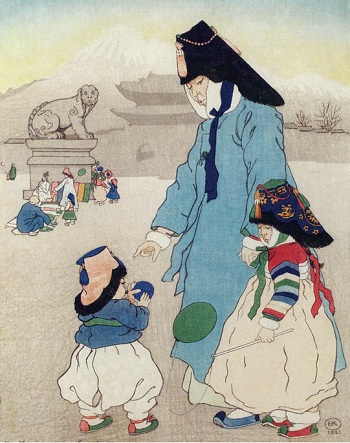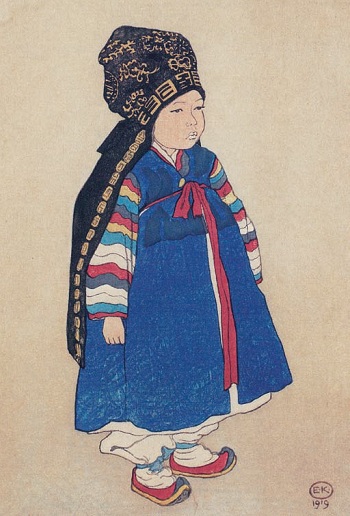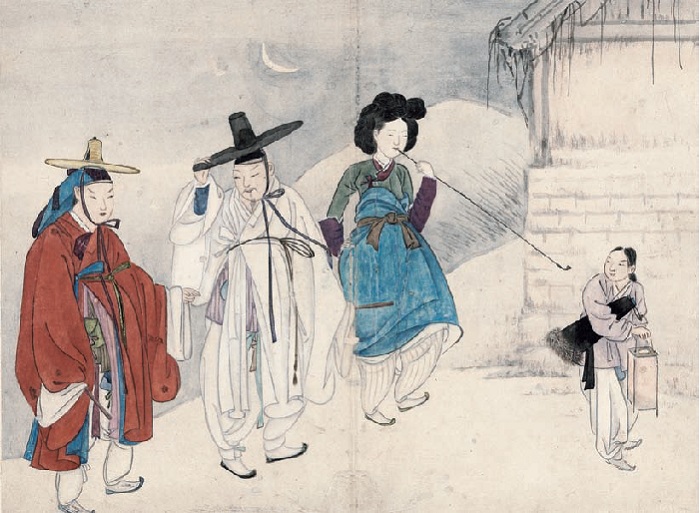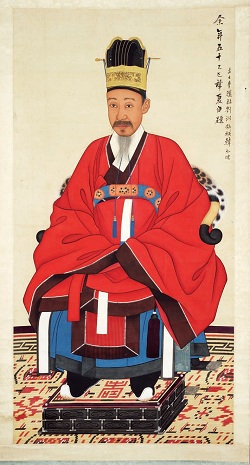View this article in another language
- 한국어
- English
- 日本語
- 中文
- العربية
- Español
- Français
- Deutsch
- Pусский
- Tiếng Việt
- Indonesian
*This is the eleventh part in our series, “Gat, traditional headgear in Korea.”
Traditional Headgear as Depicted in the Arts-- A Gallery of Hats
Official Hats in Paintings
 The nambawi, as interpreted by Elizabeth Keith (1887-1956)
The nambawi, as interpreted by Elizabeth Keith (1887-1956)
The above image is a woodcut by the English artist Elizabeth Keith who visited Korea around 1920. It depicts a mother and two little daughters, holding hands and walking in front of Gwanghwamun Square, with a statue of a haetae in the background, a mythical fire-eating, horned, lion-like animal that fights for justice, knows between good and evil and protects against disaster. A nambawi style of headgear was used by both men and women of all ages, also going by the name of pungdengi, meaning "beetle," or nani, meaning "ear warmers," or ieom, meaning "ear covers." It is also said that the hat was initially named after its inventor, Nam Ba-wi. The traditional winter hat with a fur-lined base is designed to fully cover the forehead, ears and back of the neck.
The hat was originally favored by old men as winter headgear worn underneath the horsehair hat to cover their ears. Derived from a formal winter cap of the early Joseon period called a ieom, it initially saw everyday usage by the upper class, but later spread to commoners, worn along with formal dress as well as with military uniforms under the beonggeoji, a soldier's or military slave's hat.
The hat is usually open at the top, and the lower part is curved in three parts. The edge of the hat is lined with 4 to 7 centimeters of fur and there is approximately a 4.5 centimeter slit in the middle of the back of its crown. It is decorated on its front and back with tassels, knots and jewelry made of coral cord and jade, while there are two straps attached to either side connecting the front and back parts of the hat. Sometimes, it also had detachable fur-lined flaps to cover the cheeks and chin, especially in the case of those designed for women. Although the usual combination of materials involved thick silk for the exterior and cotton flannel for the interior, it was at times substituted in favor of cotton for the inside and wool on the outside. The common color for the outer fabric was black, while black, green or red was used for the inner linings. Sometimes, navy, purple, maroon, light violet and light green were used for the outer surface and a yellow-dyed fabric was used for the inner one. The fur lining was usually black, dark brown or red-black in color, and the tassels were mostly pink or bold pink. Nambawi for females were colorfully and luxuriously adorned with gold-gilded decorations of cranes, butterflies, oriental phoenixes, chrysanthemums and other auspicious patterns.
Different materials were used for different ranks. Silk and marten fur were used for hats worn by senior officials while for subordinate officials of the third to ninth ranks, materials used were restricted to silk tabby and rat hide. The common people initially used otter hide, later replaced with weasel skin due to high costs. There was another type of nambawi worn in the spring or autumn for old people living in luxury and those in poor health. Typically, the nambawi was worn in wintertime under a horsehair hat, and sometimes under golden coronets and the official samo hat that government officials wore in court.

The bokgeon, a headdress for both children and adults
A little boy, maybe two or three years of age, is in a children's jacket with multicolor-striped sleeves and a sleeveless coat with a bokgeon on his head. This appears to be an outfit for New Year's Day. The gilt decoration imprinted across the headdress is presumably composed of letters and patterns conveying good wishes for the boy's longevity and fortune.
The old man in the other picture, who appears to be a scholar, is also wearing the same kind of headdress. Joseon era scholars wore such hats along with white over coats, such as the simui and the hakchangui.
Bokgeon is a type of traditional headgear. The rear part is curved, and there are two pleats above each ear. Two straps sewn inside the lower pleats are tied at the back. The hat is made of black silk or silk gauze, and it is called bokgeon, literally meaning "full width hood," as the full width of a piece of cloth is used to make one. During the Joseon era, it was worn by noblemen and COnfucian scholars together with simui and hakchangui, and some young men wore it above their topknot before putting on a straw hat. Today, it is usually worn by baby boys on their first birthday or on traditional holidays. A passage regarding hats in "Random Expatiations of Oju," a vast volume of books describing various objects from all areas and written in the 18th century by scholar Yi Gyu-gyeong, says that, "During the Chinese Han Dynasty, many kings and the nobility admired the attire of scholars and considered wearing the bokgeon an elegant way to dress. Consequently, the bokgeon, which used to be worn by people of humble origins, became part of scholarly attire by the end of the dynasty."
A byeolgam with a chorip and a vivid red uniform
This painting is the famous artist Shin Yun-bok's "A Secret Trip At Night." In the dead of the night, when a crescent moon adorns the eastern sky, the scene depicts the gathering of four people outside a gisaeng house. There is a gisaeng, a female entertainer who is sometimes a singer, drinking partner or perhaps prostitute, depending on the situation and people involved, a yangban, or aristocrat, a byeolgam, who is a low-ranking official, and, finally, a servant boy. Both the aristocrat with his black horsehair bat and the woman, with her long tobacco pipe, are wearing finely sewn quilt jackets, under-drawers and wristlets. The way the moon has waned indicates it is a late winter night. In contrast to the aristocrat in white with his broad-brimmed hat, is the byeolgam who is wearing a straw chorip hat and a red uniform.

The lower official is saying something as he points with his index and middle finger. Despite her social status, the woman puffing away on her pipe looks even more confident than the aristocrat in his black, horsehair hat. This painting represents a period when the popular fashion trend among women was to wear their skirt lifted up, to show their under-drawers, thereby accentuating the fullness of the skirt. The servant boy on the right is holding a lamp and a fur hat.
Despite the fact that byeolgam held what was generally regarded as a low official rank, they were in a position to assist the king from up close, and their attire was always of an outstanding color. They wore an orange-colored straw hat, which stood out even from a distance, and their dallyeong, the official's robe with a round collar, their jingnyeong, a man's coat with a straight collar, and their cheomni, a man's coast with pleats, were all painted in a vivid dark red. Furthermore, the various styles of belts worn by the byeolgam were enough to represent their prerogatives.
Worn by boys after their coming-of-age ceremony, the chorip was a popular hat for Confucian scholars and commoners until the heungnip, the nobleman's outdoor black hat, came into common use. The hat is narrow-brimmed, its edges bent up, and the crown is quite small. It can be even said that the hat is just placed on the top of the head rather than being fully worn. Therefore, the headband worn around the head to fix the topknot and accessories attached to it were bound to be seen under the straw hat and as a natural consequence, hair decorations became increasingly elaborate. When heungnip came in style, however, the chorip because a distinctive hat for male servants, including the byeolgam. In particular, its orange color gives the impression of liveliness, pleasure and openness. As its high saturation makes the color distinctive everywhere, it elicits positive emotions at events held outside the royal palace. Accordingly, when byeolgams escorted a royal carriage, the orange-colored straw hat, as part of their official uniform, was presumably sufficient to vitalize the event by showing off the grandeur of the ceremony and creating a festive atmosphere.

Heungseon, the Daewongun, in a five-line coronet
The man in the picture is King Heungseon (1820-1898, r. 1863-1873), the Daewongun, or, "Prince of the Great Court," shown here in his ceremonial jobok attire for kings and officials, and wearing a golden crown. The jobok was only worn when greeting foreign envoys, proclaiming royal edicts or presenting the tributary prose to Chinese emperors on New Year's Day, the Winter Solstice and holidays. Nowadays, ritual specialists wear a seven-lined coronet during the Royal Ancestral Memorial Rite of Jongmyo. This is based on the changed standard of the Korean Empire (1897-1910), a period of time when Joseon no longer saw itself as a tributary to China that succeeded the Joseon era (1392-1897). Previously, Korean royalty and officials were customarily held at two ranks below their Chinese counterparts. For example, the Korean king was considered on the same level as a Chinese feudal lord, who ranked below the prince imperial, and a Korean first rank official was considered equal to a Chinese third rank official. However, in the period of the Korean Empire, all official ranks were elevated to the same level as those of China. The golden coronet is adorned with yang, or vertical lines, that indicate different ranks, so the coronet is also called the yangwan, or lined coronet.
According to historical records regarding the official dress code during the 16th year of Taejong's reign (1416), first rank officials wore a five-lined coronet. Those of the second rank wore a four-lined had, of the third rank a three-lined hat, of the fourth to sixth ranks a two-lined hat and of the seventh to ninth ranks a one-lined coronet (March, 16th year of Taejong's reign, "The Annals of the Joseon Dynasty"). In the meantime, crown princes wore a six-lined coronet together with the ceremonial red gangsapo robe.
The coronet is engraved with gilded arabesque patterns along the lower front rim and the whole of the back. Sometimes, the binyeo, or the traditional long hairpin inserted through the coronet, was also gold-plated, hence the name "golden coronet." Traditionally in China, the hairpin was designed to be put in through the topknot and coronet, to fix the coronet in place and to prevent it from falling off when the wearer bowed down. Korea largely adopted the Chinese style, except that the Korean variation attached strings to the coronet that were connected to the hairpin and tied beneath the wearer's chin. This was because, unlike the Chinese topknot which was big and soft, it was impossible to put a hairpin through a Korean-style topknot. During the winter when the nambawi was worn under the coronet, the strings had to be loosened.
*This series of article has been made possible through the cooperation of the National Research Institute of Cultural Heritage. (Source: Intangible Cultural Heritage of Korea)
Traditional Headgear as Depicted in the Arts-- A Gallery of Hats
Official Hats in Paintings

"New Year's Shopping, Seoul" (1921), Elizabeth Keith
The above image is a woodcut by the English artist Elizabeth Keith who visited Korea around 1920. It depicts a mother and two little daughters, holding hands and walking in front of Gwanghwamun Square, with a statue of a haetae in the background, a mythical fire-eating, horned, lion-like animal that fights for justice, knows between good and evil and protects against disaster. A nambawi style of headgear was used by both men and women of all ages, also going by the name of pungdengi, meaning "beetle," or nani, meaning "ear warmers," or ieom, meaning "ear covers." It is also said that the hat was initially named after its inventor, Nam Ba-wi. The traditional winter hat with a fur-lined base is designed to fully cover the forehead, ears and back of the neck.
The hat was originally favored by old men as winter headgear worn underneath the horsehair hat to cover their ears. Derived from a formal winter cap of the early Joseon period called a ieom, it initially saw everyday usage by the upper class, but later spread to commoners, worn along with formal dress as well as with military uniforms under the beonggeoji, a soldier's or military slave's hat.
The hat is usually open at the top, and the lower part is curved in three parts. The edge of the hat is lined with 4 to 7 centimeters of fur and there is approximately a 4.5 centimeter slit in the middle of the back of its crown. It is decorated on its front and back with tassels, knots and jewelry made of coral cord and jade, while there are two straps attached to either side connecting the front and back parts of the hat. Sometimes, it also had detachable fur-lined flaps to cover the cheeks and chin, especially in the case of those designed for women. Although the usual combination of materials involved thick silk for the exterior and cotton flannel for the interior, it was at times substituted in favor of cotton for the inside and wool on the outside. The common color for the outer fabric was black, while black, green or red was used for the inner linings. Sometimes, navy, purple, maroon, light violet and light green were used for the outer surface and a yellow-dyed fabric was used for the inner one. The fur lining was usually black, dark brown or red-black in color, and the tassels were mostly pink or bold pink. Nambawi for females were colorfully and luxuriously adorned with gold-gilded decorations of cranes, butterflies, oriental phoenixes, chrysanthemums and other auspicious patterns.
Different materials were used for different ranks. Silk and marten fur were used for hats worn by senior officials while for subordinate officials of the third to ninth ranks, materials used were restricted to silk tabby and rat hide. The common people initially used otter hide, later replaced with weasel skin due to high costs. There was another type of nambawi worn in the spring or autumn for old people living in luxury and those in poor health. Typically, the nambawi was worn in wintertime under a horsehair hat, and sometimes under golden coronets and the official samo hat that government officials wore in court.

"Korean boy in Holiday Dress" (1919), Elizabeth Keith
The bokgeon, a headdress for both children and adults
A little boy, maybe two or three years of age, is in a children's jacket with multicolor-striped sleeves and a sleeveless coat with a bokgeon on his head. This appears to be an outfit for New Year's Day. The gilt decoration imprinted across the headdress is presumably composed of letters and patterns conveying good wishes for the boy's longevity and fortune.
The old man in the other picture, who appears to be a scholar, is also wearing the same kind of headdress. Joseon era scholars wore such hats along with white over coats, such as the simui and the hakchangui.
Bokgeon is a type of traditional headgear. The rear part is curved, and there are two pleats above each ear. Two straps sewn inside the lower pleats are tied at the back. The hat is made of black silk or silk gauze, and it is called bokgeon, literally meaning "full width hood," as the full width of a piece of cloth is used to make one. During the Joseon era, it was worn by noblemen and COnfucian scholars together with simui and hakchangui, and some young men wore it above their topknot before putting on a straw hat. Today, it is usually worn by baby boys on their first birthday or on traditional holidays. A passage regarding hats in "Random Expatiations of Oju," a vast volume of books describing various objects from all areas and written in the 18th century by scholar Yi Gyu-gyeong, says that, "During the Chinese Han Dynasty, many kings and the nobility admired the attire of scholars and considered wearing the bokgeon an elegant way to dress. Consequently, the bokgeon, which used to be worn by people of humble origins, became part of scholarly attire by the end of the dynasty."
A byeolgam with a chorip and a vivid red uniform
This painting is the famous artist Shin Yun-bok's "A Secret Trip At Night." In the dead of the night, when a crescent moon adorns the eastern sky, the scene depicts the gathering of four people outside a gisaeng house. There is a gisaeng, a female entertainer who is sometimes a singer, drinking partner or perhaps prostitute, depending on the situation and people involved, a yangban, or aristocrat, a byeolgam, who is a low-ranking official, and, finally, a servant boy. Both the aristocrat with his black horsehair bat and the woman, with her long tobacco pipe, are wearing finely sewn quilt jackets, under-drawers and wristlets. The way the moon has waned indicates it is a late winter night. In contrast to the aristocrat in white with his broad-brimmed hat, is the byeolgam who is wearing a straw chorip hat and a red uniform.

"Yaguemmohaeng," or, "A Secret Trip At Night" (1758), by Shin Yun-bok
The lower official is saying something as he points with his index and middle finger. Despite her social status, the woman puffing away on her pipe looks even more confident than the aristocrat in his black, horsehair hat. This painting represents a period when the popular fashion trend among women was to wear their skirt lifted up, to show their under-drawers, thereby accentuating the fullness of the skirt. The servant boy on the right is holding a lamp and a fur hat.
Despite the fact that byeolgam held what was generally regarded as a low official rank, they were in a position to assist the king from up close, and their attire was always of an outstanding color. They wore an orange-colored straw hat, which stood out even from a distance, and their dallyeong, the official's robe with a round collar, their jingnyeong, a man's coat with a straight collar, and their cheomni, a man's coast with pleats, were all painted in a vivid dark red. Furthermore, the various styles of belts worn by the byeolgam were enough to represent their prerogatives.
Worn by boys after their coming-of-age ceremony, the chorip was a popular hat for Confucian scholars and commoners until the heungnip, the nobleman's outdoor black hat, came into common use. The hat is narrow-brimmed, its edges bent up, and the crown is quite small. It can be even said that the hat is just placed on the top of the head rather than being fully worn. Therefore, the headband worn around the head to fix the topknot and accessories attached to it were bound to be seen under the straw hat and as a natural consequence, hair decorations became increasingly elaborate. When heungnip came in style, however, the chorip because a distinctive hat for male servants, including the byeolgam. In particular, its orange color gives the impression of liveliness, pleasure and openness. As its high saturation makes the color distinctive everywhere, it elicits positive emotions at events held outside the royal palace. Accordingly, when byeolgams escorted a royal carriage, the orange-colored straw hat, as part of their official uniform, was presumably sufficient to vitalize the event by showing off the grandeur of the ceremony and creating a festive atmosphere.

Heungseon, the Daewongun (1820-1898)
Heungseon, the Daewongun, in a five-line coronet
The man in the picture is King Heungseon (1820-1898, r. 1863-1873), the Daewongun, or, "Prince of the Great Court," shown here in his ceremonial jobok attire for kings and officials, and wearing a golden crown. The jobok was only worn when greeting foreign envoys, proclaiming royal edicts or presenting the tributary prose to Chinese emperors on New Year's Day, the Winter Solstice and holidays. Nowadays, ritual specialists wear a seven-lined coronet during the Royal Ancestral Memorial Rite of Jongmyo. This is based on the changed standard of the Korean Empire (1897-1910), a period of time when Joseon no longer saw itself as a tributary to China that succeeded the Joseon era (1392-1897). Previously, Korean royalty and officials were customarily held at two ranks below their Chinese counterparts. For example, the Korean king was considered on the same level as a Chinese feudal lord, who ranked below the prince imperial, and a Korean first rank official was considered equal to a Chinese third rank official. However, in the period of the Korean Empire, all official ranks were elevated to the same level as those of China. The golden coronet is adorned with yang, or vertical lines, that indicate different ranks, so the coronet is also called the yangwan, or lined coronet.
According to historical records regarding the official dress code during the 16th year of Taejong's reign (1416), first rank officials wore a five-lined coronet. Those of the second rank wore a four-lined had, of the third rank a three-lined hat, of the fourth to sixth ranks a two-lined hat and of the seventh to ninth ranks a one-lined coronet (March, 16th year of Taejong's reign, "The Annals of the Joseon Dynasty"). In the meantime, crown princes wore a six-lined coronet together with the ceremonial red gangsapo robe.
The coronet is engraved with gilded arabesque patterns along the lower front rim and the whole of the back. Sometimes, the binyeo, or the traditional long hairpin inserted through the coronet, was also gold-plated, hence the name "golden coronet." Traditionally in China, the hairpin was designed to be put in through the topknot and coronet, to fix the coronet in place and to prevent it from falling off when the wearer bowed down. Korea largely adopted the Chinese style, except that the Korean variation attached strings to the coronet that were connected to the hairpin and tied beneath the wearer's chin. This was because, unlike the Chinese topknot which was big and soft, it was impossible to put a hairpin through a Korean-style topknot. During the winter when the nambawi was worn under the coronet, the strings had to be loosened.
*This series of article has been made possible through the cooperation of the National Research Institute of Cultural Heritage. (Source: Intangible Cultural Heritage of Korea)
![Gat, traditional headgear in Korea [10]](/upload/content/image/1396945520376.jpg)
![Gat, traditional headgear in Korea [9]](/upload/content/image/1396331775823.jpg)
![Gat, traditional headgear in Korea [8]](/upload/content/image/1395720334038.jpg)
![Gat, traditional headgear in Korea [7]](/upload/content/image/1395108155289.jpg)
![Gat, traditional headgear in Korea [6]](/upload/content/image/1393924045608.jpg)
![Gat, traditional headgear in Korea [5]](/upload/content/image/1393319340768.jpg)
![Gat, traditional headgear in Korea [4]](/upload/content/image/1392690825210.jpg)
![Gat, traditional headgear in Korea [3]](/upload/content/image/1392095636707.jpg)
![Gat, traditional headgear in Korea [2]](/upload/content/image/1391590339998.jpg)
